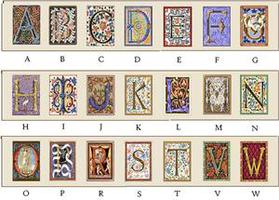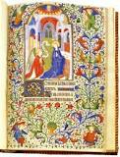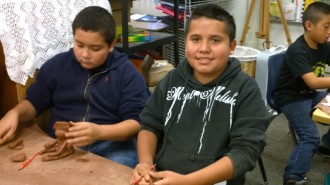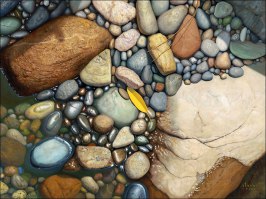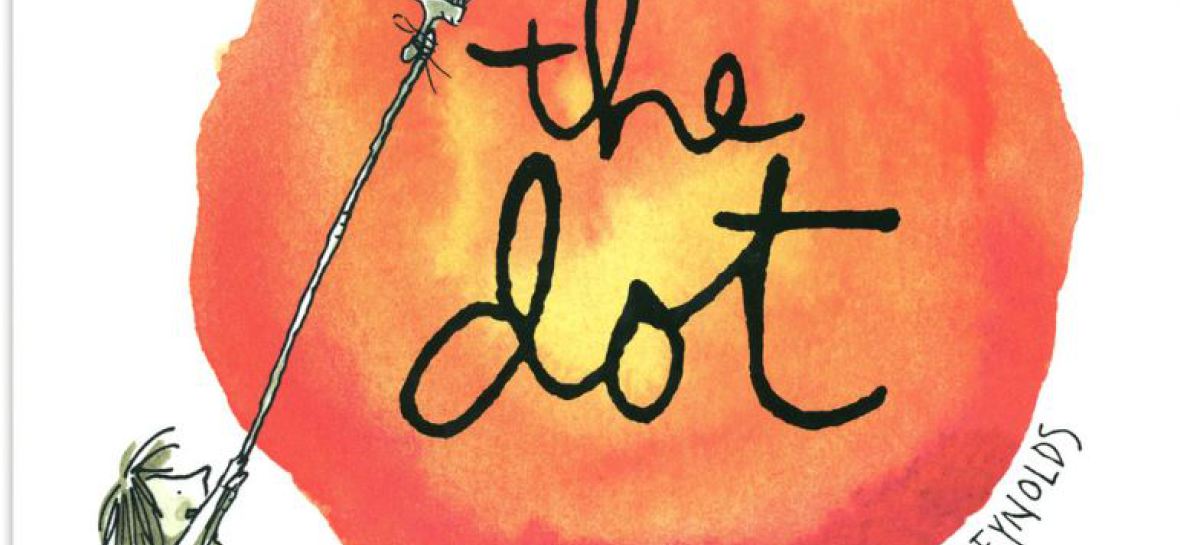

Create an Illuminated Alphabet Word Book~ Lesson From the Getty
Students create a class alphabet book or "ABCDarium," a book that uses images of animals or objects to illustrate each letter of the alphabet. The book is in the style of a medieval illuminated manuscript and incorporates both art and writing. Students decorate large uppercase letters of the alphabet and draw an original picture to illustrate each letter.
I got so excited when I found this lesson from Getty. I was thrilled to see the illuminated manuscripts at the Huntington Library and Gardens. I love the glow of the letters and pictures, and the fairytale images just captured my imagination. I wish I could have seen these books being made. I will have to settle with making them myself with my wee wonderers. I put students in groups of four, and had pre-drawn and cut the letters out of oak tag and sprayed glued them on one side. This let the wee ones put the shining paper and jewels on the letters much easier. When I put the letters onto their page to be bound into the book the letters really stood out.
.
|
Learning Objectives |
||
|
Students will be able to: a given letter of the alphabet. sentence describing the animal or object they have illustrated for their assigned letter. Art Teacher and older artists take dictation for the Wee ones. |
|
Materials |
|||
|
• Uppercase letters of the alphabet drawn in oak tag on pre cut for 12X 18 in paper patterns: tin foil, gold tissue paper, and vellum paper |
|||
|
Lesson Steps |
|||
|
1. Using the Plant and Animal Alphabet Coloring Book, photocopy one or two letters or a complete alphabet for each student using the black and white pages as a blackline master. |
|||
2. Introduce the following vocabulary: illuminate, manuscript, handmade, hue, reflective, texture, design, collage, author, and illustrator.
3. Show images from the Getty Museum of decorated letters from the illuminated manuscripts collection. Using the new vocabulary, have a discussion with the students about what they see. Ask students the following questions: What colors do you see? Do you see shiny areas? What materials do you think the artists used to make those areas shiny and reflective? Do you see different hues in the same color family, such as light green and dark green? Is it difficult or easy to see the alphabet letter when a design is part of the letter? How do art, writing, and reading all come together in these books? Do you think this is this more like a painting or more like a book? Why? What does an author do? What does an illustrator do? How do you know? Can the author and an illustrator of a book be the same person? What makes you say this? What is your evidence? Encourage students to speak in complete, coherent sentences.
4. Pass out different types of paper. Explain to students that they will tear the paper by hand into a variety of shapes to create a collage design in the letter. Students will lay down their paper bits onto the cut our letter. Encourage them to experiment with overlapping the papers to create different textures, contrasts, and hues.
5. After the letters dry, ask students to
each choose one. Pass out one sheetf o 8 1/2 x 11 in. paper to each student. Ask students to draw a picture of an object or animal that begins with their letter For example,
students who chose ted the letter S could draw a snail, a snake, or a stegosaurus. Students should draw on the paper
horizontally. Students could also trace a stencil.
6. Give each student a 12 X 18 in. piece of paper with a
preprinted sentence starter centered in the top 1/3 of the paper that goes with their illustrated letter. For example, "S is for ____________." Each student will dictate a sentence starting
with his or her chosen letter that describes the image. The sentence should include adjectives to describe the illustration. For example, a student might say, "S is for a spotted salamander hiding
under a leaf." Glue Letter and illustration on page.
7. Make a class book consisting of a title
page, each student's illuminated letter and sentence/illustration page that goes with the illuminated letter. Place the book in a special area of the room for all students and guests to enjoy. You
may also wish to display the book at the school's open house or at other campus events. After the year is up if the book is in good shape, donate it to the school library so when they are in
kinder they will see it and revisit it as an old friend.
My Favorite Alphabet Books
Artful Teaching
Mrs. Schellenberg & Young Artists
Ralph Waldo Emerson's Poem: Success- to leave the world a bit better, whether by a healthy child, a garden patch or a redeemed social condition; To know even one life breathed easier because of you.
Thank you AT&T
We used the wiring for our artful galimotos

